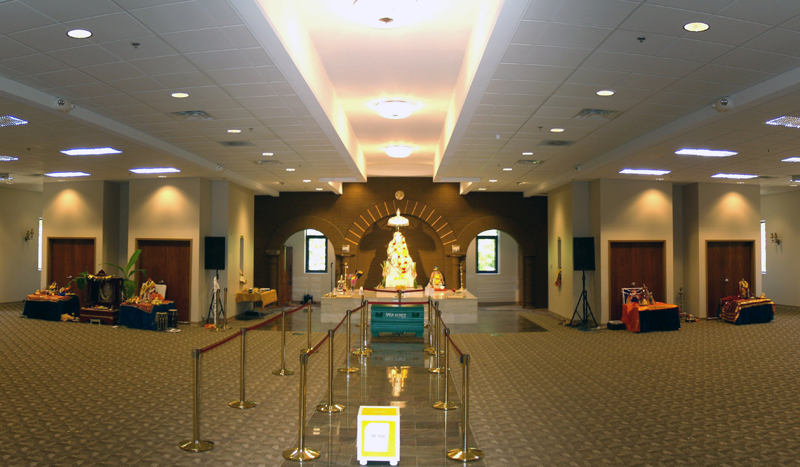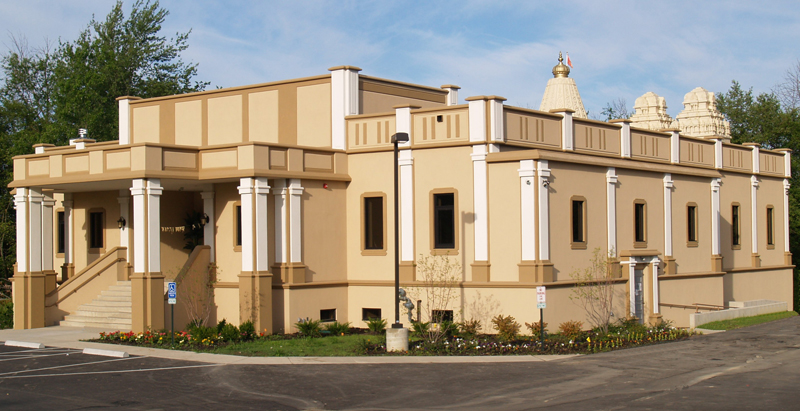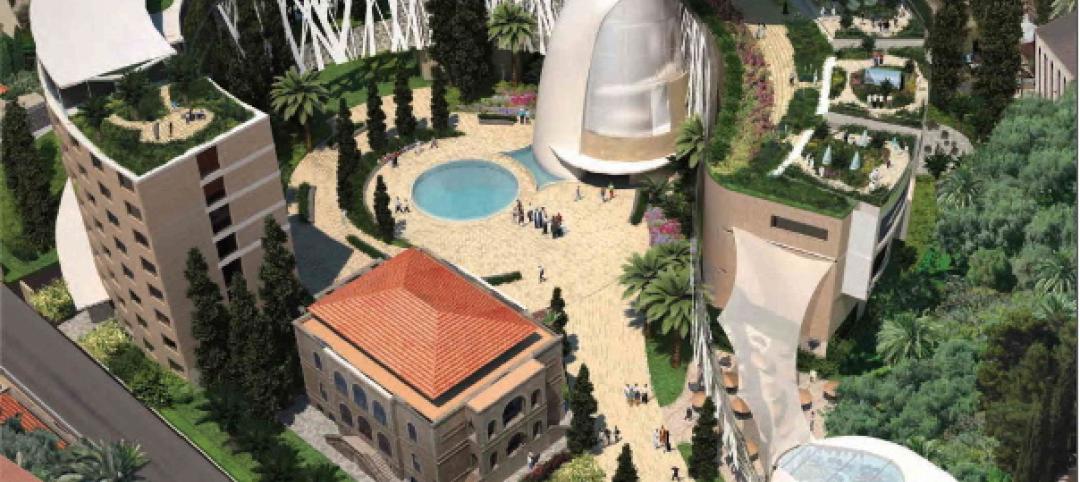Maverick Builders, of Grove City, Ohio, has built numerous churches over the years, some of them metal building systems. In recent times, their business has expanded to include houses of worship for a variety of religions. In 2012, they completed their first temple of Sri Saibaba, a sect related to the Hindu religion, with its origins in 19th century India. There are active devotees in many countries, including the US. In 2000, the Sri Saibaba Temple Society of Central Ohio was founded with its primary goal being the construction of a temple in Lewis Center, OH. It took a decade, but they achieved that goal. Design began in 2010, construction began in 2011, and the temple was completed by April 2012. The temple now regularly welcomes 400 worshippers.
Despite Maverick’s extensive experience in the religious sector, this project posed a few unfamiliar challenges. Some of the challenges related to specific religious requirements of the building, which impacted both design and construction. There were also structural aspects that were uncommon for metal building systems that had to be solved.
The 16,000-sf temple, in the wooded suburbs north of Columbus, OH, utilized a Star Building System. Although it does not look it, it is a single-slope roof structure. Parapet wall extensions of various heights create interest and depth to the exterior elevations. The walls are metal wall panels covered with a multi-colored EIFS finish with special accent features. The overall effect is more like a traditional stone-column structure with brightly colored plaster infill walls. A membrane rubber roof was installed over structural metal decking, supported by the Star structure.
The temple is a two-story building, with a basement level that rises 4 feet above grade. The second level is on a suspended precast concrete floor. This is an atypical condition, as many metal building systems are built as slab-on-grade. Engineering to properly transfer the roof and wall loads to the foundation is a little trickier than normal, and was made more complicated by significant point loads of large ornamental structures at several locations on the roof.
There were a number of unusual design features. Maverick Builders’ owner, Paul McKnight, recalls that some of the interior spaces weren’t located where they would be if designed from a purely architectural standpoint. The beliefs of the congregation required specific compass-orientations for certain rooms. The temple sanctuary had to be oriented correctly, as did the direction of staircase travel, and even the bathroom layout. Both interior and exterior designs feature walkways that circle the building and main prayer hall, which are used as part of the religious ceremonies.
The roof bears several heavy ornamental elements, each of which requires a roof curb and appropriate engineering for the increased load. The clear span pre-engineered rafters were designed to support seven point loads. The largest of these is the 2-ton shikhara, the pyramid-like structure that is the most prominent exterior feature of a Hindu temple. It is located directly over the focal point of the sanctuary.
In addition, the construction schedule needed to be coordinated with the owners so that appropriate blessings and religious rituals could be performed at certain stages of construction, such as when sacred objects were being installed. This sometimes involved dozens of people occupying the site while it was still under construction, a challenging and risky situation that contractors usually like to avoid. McKnight, however, recognized the importance of making these ceremonies possible, “to make sure that everything is blessed properly. It will bring good luck on everyone involved,” he says. “In today’s times, you need all the good luck you can get, so we happily cooperated with all of those requirements.”
There was one crucial phase of construction that could not be performed until the entire building was otherwise complete. The 4000 lb., Italian marble statue of Saibaba, the focal point of the sanctuary, was the last thing to be placed in the building. In order to accomplish this, Maverick had to build a framed opening into the roof directly over the intended location of the statue. It was temporarily sealed for weather tightness during construction. When everything else was complete, the roof was opened, and the statue was lowered in by crane. A domed ceiling was placed over the statue, the roof was permanently sealed, and the large shikhara was installed on the roof.
Maverick Builders was awarded a Master Builder Award for “Best Specialty Building,” presented at Star’s annual national sales meeting.
On the website of the Saibaba Temple Society of Central Ohio, there is a page devoted to construction updates, where it says, “It is often told that being able to participate and contribute in a noble activity like building a temple that will serve several thousand people year after year is a once in a lifetime opportunity.” It appears this may not be true for Maverick Builders, however. Word of the great success of this project has apparently gotten around to other congregations, and there may be more temples and more such opportunities in Maverick’s future.

Project: Sri Saibaba Temple, Lewis Center, Ohio
Design/Builder – Maverick Builders, Inc., Grove City Ohio
Architect – CDI, Design, LLC, (Maverick’s in-house designer)
Building manufacturer – Star Building Systems
Steel erection – Maverick Builders
HVAC – Command Heating
Plumbing – Command Plumbing
Electric – Westlake Electric
Concrete – Eagle Concrete
Framing & drywall – Fry Drywall
Painting – Listing Painting
EIFS – Damron Finish Systems
Roofing – Harmac Roofing
Related Stories
| Apr 16, 2014
Upgrading windows: repair, refurbish, or retrofit [AIA course]
Building Teams must focus on a number of key decisions in order to arrive at the optimal solution: repair the windows in place, remove and refurbish them, or opt for full replacement.
| Apr 9, 2014
Steel decks: 11 tips for their proper use | BD+C
Building Teams have been using steel decks with proven success for 75 years. Building Design+Construction consulted with technical experts from the Steel Deck Institute and the deck manufacturing industry for their advice on how best to use steel decking.
| Apr 2, 2014
8 tips for avoiding thermal bridges in window applications
Aligning thermal breaks and applying air barriers are among the top design and installation tricks recommended by building enclosure experts.
| Mar 31, 2014
Extreme conversion: Soaring Canadian church transformed into contemporary library
Even before the St. Denys-du-Plateau Church was converted into a library, it was an unusual building, with a towering nave designed to mimic a huge tent inflated by the wind.
| Mar 26, 2014
Callison launches sustainable design tool with 84 proven strategies
Hybrid ventilation, nighttime cooling, and fuel cell technology are among the dozens of sustainable design techniques profiled by Callison on its new website, Matrix.Callison.com.
| Mar 20, 2014
Common EIFS failures, and how to prevent them
Poor workmanship, impact damage, building movement, and incompatible or unsound substrate are among the major culprits of EIFS problems.
| Mar 12, 2014
14 new ideas for doors and door hardware
From a high-tech classroom lockdown system to an impact-resistant wide-stile door line, BD+C editors present a collection of door and door hardware innovations.
| Feb 6, 2014
First Look: Center for Hope will welcome world's religious to Jerusalem
The space, backed by The Elijah Interfaith Institute, is meant to "bring about world-changing peace and harmony."
| Jan 28, 2014
16 awe-inspiring interior designs from around the world [slideshow]
The International Interior Design Association released the winners of its 4th Annual Global Excellence Awards. Here's a recap of the winning projects.
| Jan 13, 2014
Custom exterior fabricator A. Zahner unveils free façade design software for architects
The web-based tool uses the company's factory floor like "a massive rapid prototype machine,” allowing designers to manipulate designs on the fly based on cost and other factors, according to CEO/President Bill Zahner.

















